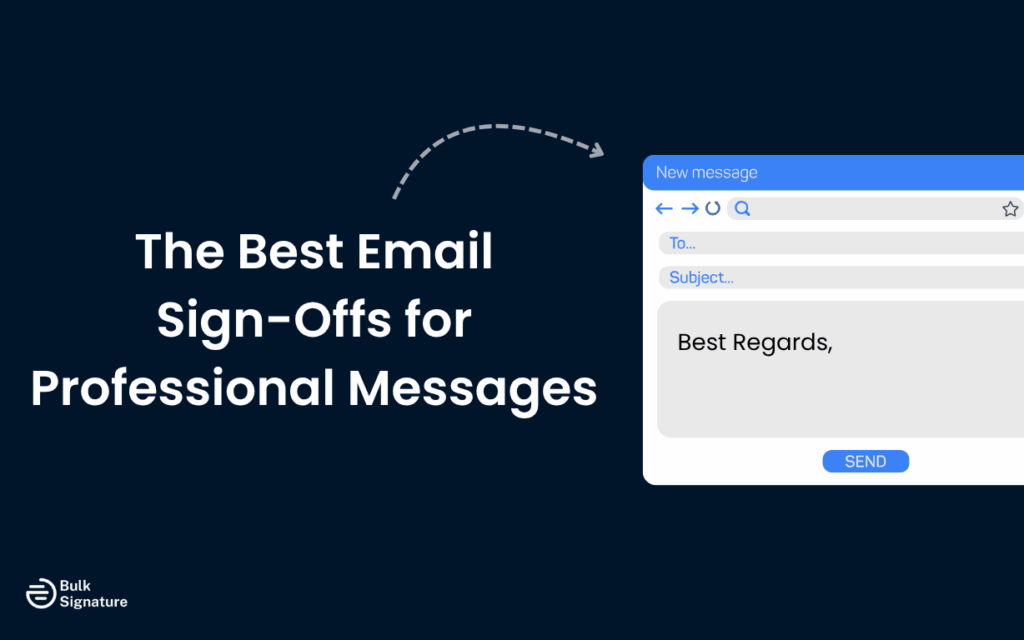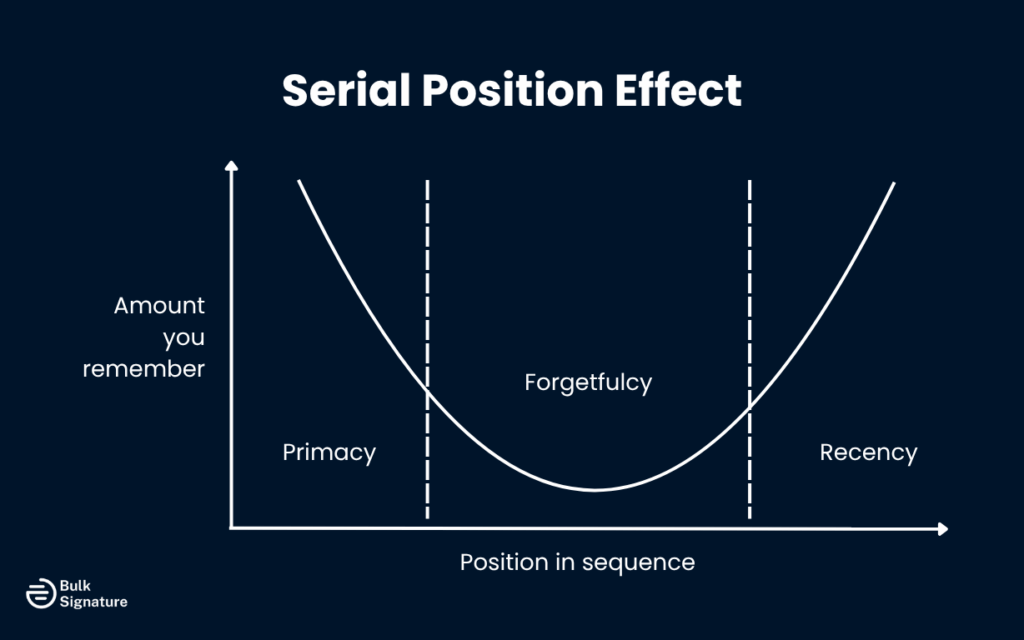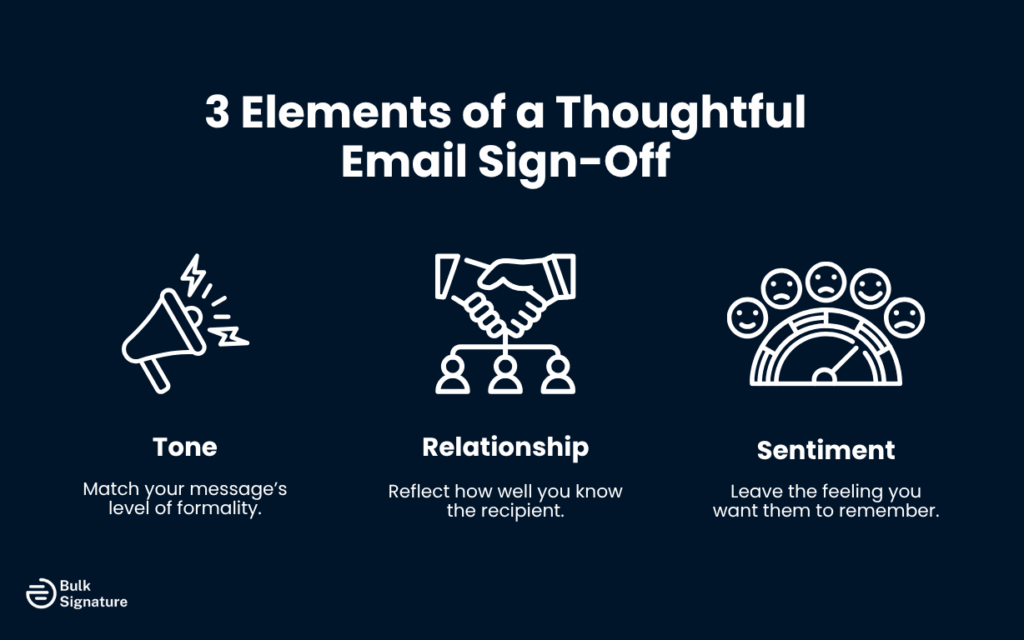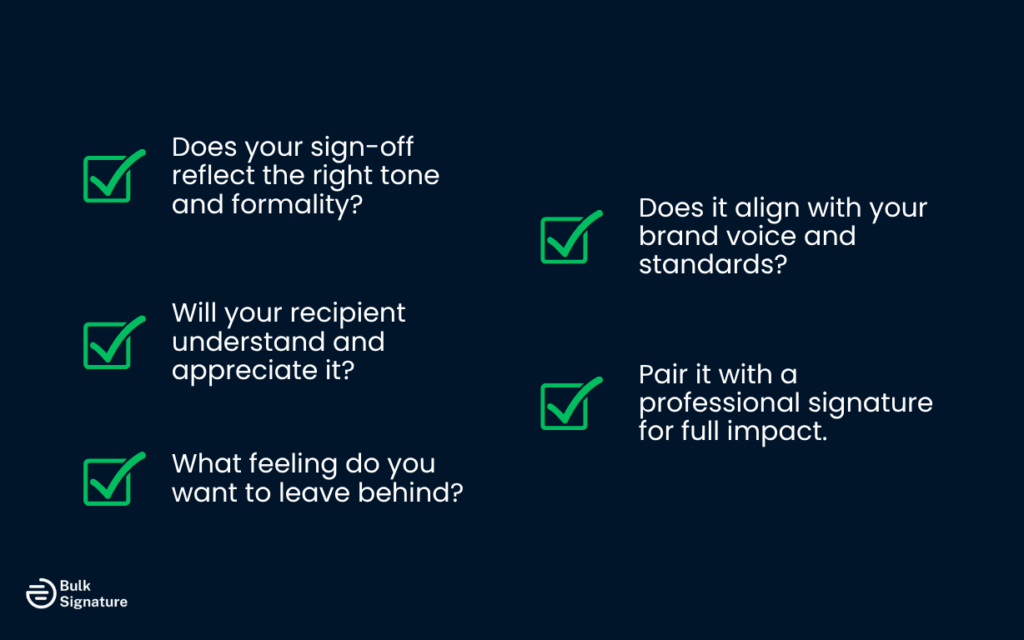
Your email might have the perfect subject line, a clear message, and a polished tone.
But want to know what really leaves a lasting positive impression?
It’s those final two or three words in your email sign-offs. Get it right, and you’ll come across as trustworthy and professional. But if you get it wrong? Things can get a bit awkward.
If you’re not quite sure which sign-off to use and when, we’ve created the following guide with the best email sign-offs for formal, semi-formal, and casual communication. Read on for practical examples, tone guidelines, and key insights into how you can use centralized tools like BulkSignature to keep your sign-offs consistent across your organization.
Why Your Email Sign-Offs Matters More Than You Think
When writing an email, it’s easy to focus on making an impact with your subject line and greeting. But the closing of your email is just as important. Why? Because your email sign-off is like a final, firm handshake that reassures your recipient that you are trustworthy, respectful, confident, and intentional.
Here’s a quick look at the psychology behind why your sign-off matters just as much as your greeting.
The Psychology of First and Last Impressions
In communication psychology, it’s well established that people remember beginnings and endings most vividly. This is called the Serial Position Effect.

So in an email, this means your subject line and your sign-off are just as important. Together, they frame the entire message, with the subject line drawing readers in and the sign-off leaving an impression.
Even small word choices can create a subtle difference in how a recipient feels about you and your message. For example, a formal sign-off like Sincerely can reinforce respect and seriousness, while a warmer closing like Best regards can signal professionalism without coming across too stiff.
Readers pick up on these small details, so it’s important to be mindful of how you come across in your professional and personal sign-offs.
Reinforcing Your Company’s Brand Voice
If you have to send emails for work, your emails represent the brand and company you work for. This means that collectively, every email you send (and every email that other employees send) forms part of your organization’s brand voice.
And when different people use different tones in their sign-offs, like Cheers from one sender, Warm regards from another, or no sign-off at all, the inconsistency can confuse recipients, weakening the company’s overall brand reputation.
By centralizing email sign-off standards, either in a written policy or with a tool like BulkSignature, companies can maintain:
- Tone alignment
- Professional consistency
- Compliance and brand standards
In other words, every message sent becomes a unified reflection of the values and standards set by your organization.
Want to learn more about keeping your emails consistent and on-brand across your organization? Check out our resources:
What Makes an Appropriate Sign-Off

Email sign-offs should reflect three key elements of your message:
- The tone of your message.
- The context of your relationship with the recipient.
- The sentiment you want to express.
Let’s look at how each of these elements influences your sign-off choice.
Matching the Sign-Off to the Email’s Tone and Intent
Every email carries a tone, such as formal, semi-formal, or casual. If your closing is mismatched, your message can come across as awkward or off-brand.
- For more formal business emails, stick with classic email sign-offs like Sincerely or Yours faithfully and avoid overly casual sign-offs.
- For semi-formal emails, use polished but friendly sign-offs, such as Best regards or Many thanks.
- And for informal or friendly emails, you can use more casual sign-offs like Thanks again or Cheers.
Pro Tip: The more formal the message, the more traditional your closing should be.
Considering Your Relationship With the Recipient
Another element to consider is your relationship with the recipient. To build (or maintain) rapport, close your message in a way that shows respect and reinforces your connection.
Here are a few guidelines:
- New contacts or first outreach: With new contacts, always err on the side of professionalism. Sign-offs like Best regards or Sincerely are typically the best sign-offs for staying respectful and professional.
- Existing clients or business partners: With people you already know, try to balance formality with some warmth. For example, Kind regards or With appreciation both feel friendly and professional.
- Internal colleagues or team members: Casual language is typically fine with colleagues you’re comfortable with. However, don’t let your sign-off become a distraction, so try to keep things short and sweet with a sign-off like Thanks or All the best.
Pro Tip: When in doubt, choose a sign-off that reflects how you would close a conversation with the same person in real life.
Expressing the Sentiment You’d Like to Leave Behind
Emails can sometimes have an underlying emotion, such as appreciation, anticipation, or openness. The right sign-off can help reinforce that tone.
- When expressing gratitude, choose a closing like Thank you, Many thanks, or With gratitude to show respect and appreciation.
- When emphasizing future interactions, choose a forward-looking phrase like Looking forward or Hope to speak soon to keep your communication open and optimistic.
- When showing openness, choose a closing like All the best or Take care to show warmth and friendliness.
Pro Tip: End your email the way you want the reader to feel. If your message is warm, stay warm. If it’s professional, stay polished.
20+ Professional Email Sign-Off Examples
Looking for some inspiration for your next email? The following table shows 20+ different professional email sign-off examples for different settings and contexts.
| Setting | Examples | When to Use |
|---|---|---|
| Formal settings |
Sincerely Yours sincerely Yours faithfully Respectfully Kind regards |
When writing to senior leaders, executives, government officials, or external partners where a high level of formality is expected. Ideal for: Proposals Introductions Job applications Professional correspondence Funding bids Client outreach |
| Semi-formal settings |
Best regards Warm regards With appreciation Thank you Appreciatively |
When writing to clients, vendors, or professional contacts you communicate with regularly, but still want to maintain a professional tone. Great for: Project communication Customer service responses Partnership outreach Follow-up messages after meetings Status reports or check-ins Deliverable handoffs or confirmations |
| Casual, friendly, and personal contexts |
Best Many thanks All the best Thanks again Take care Talk soon Warm wishes Catch you soon Have a great week With gratitude Cheers |
When emailing colleagues, partners, or long-term clients you have an established relationship with. Perfect for: Everyday updates Quick follow-ups Friendly check-ins Light reminders Casual thank-you’s International team communications |
15+ Creative and Funny Email Sign-Offs for Work (Use Sparingly)
Sometimes, a touch of creativity can be a fun way to add a personal touch to your sign-off and email signature. Here are a few examples of some creative, casual email sign-offs to use in more lighthearted situations and personal settings.
| Vibe | Examples | When to Use |
|---|---|---|
| Fun and casual |
Stay awesome, Onward and upward, Keep shining, Thanks a latte, Fueled by coffee and determination, |
Within marketing, design, or creative teams, and in casual exchanges with friendly colleagues. |
| Seasonal |
Stay cool, Spookily yours, Creep it real, Happy Holidays, Warm winter wishes, Cheers to the new year, Wishing you joy and success in the new year, Merry Christmas, |
Best for holiday email marketing campaigns, end-of-year client messages, and employee appreciation emails or internal announcements. |
| Playful and sarcastic |
Keep fighting the good fight, Over and out, Insert clever sign-off here, Lukewarm regards, Cold regards, Fighting for my life, |
For internal team messages or creative departments that share a similar sense of humor and have a good rapport. |
A Final Checklist for Choosing the Right Email Sign-Off
In professional communication, the perfect email sign-off has the power to strengthen relationships, build trust, and leave a lasting impression of professionalism and respect.

If you ever find yourself in a rut and don’t quite know which sign-off would be best, here’s a quick checklist of questions to ask yourself:
- Does your sign-off reflect the appropriate tone and level of formality of your message?
- Will your recipient understand and appreciate your sign-off?
- What feeling do you want to leave behind?
- Does your sign-off align with your brand voice and company standards?
And last but not least, pair your professional email sign-off with a professional email signature for the most polished, consistent, and trustworthy impression.
Book a free demo today to see how BulkSignature can help your team send professional, confident, and on-brand emails every single time.
Frequently Asked Questions About Email Sign-Offs and Email Communication
What is the ideal professional sign-off?
The best professional sign-offs are simple, respectful, and appropriate for formal communication. Common examples that you can’t go wrong with include Best regards, Kind regards, Sincerely, and Respectfully.
What are some good informal email sign-offs?
For everyday communication or messages to colleagues you know well, informal sign-offs like Thanks, All the best, Talk soon, or Cheers work perfectly. They’re warm and conversational, but they’re also still professional.
What are some examples of creative email sign-offs?
If you’re looking for something creative, sign-offs like Keep shining, Stay awesome, Onward and upward, or Fueled by coffee and determination can work with close colleagues in casual environments.
What are some examples of friendly email sign-offs?
A few examples of friendly email sign-offs include: Warm regards, Take care, With appreciation, or Have a great week.
What is the ideal sign-off for a job application?
When applying for a job, stick to polished, traditional closings such as Sincerely, Best regards, or Kind regards. This shows that you respect the formality of the job application process.
Can I use my personal sign-off for work?
It depends. If your personal sign-off aligns with your company’s tone and culture, it might work. However, personal sign-offs aren’t always on brand, so run it by your team if you’re unsure if it’s appropriate.
What else should I include in my email sign-off?
In addition to your sign-off, your email should include a professional email signature with your full name, job title, company name, and relevant contact details such as phone number or website. It’s also a good idea to include links to your LinkedIn profile or company social pages.
Beyond your relevant contact information, your company may also want you to include relevant legal disclaimers, confidentiality notices, or regional compliance details (like GDPR statements).
If you’re struggling to keep all of these elements consistent across your team, tools like BulkSignature can help you make sure everyone’s signature and sign-off stay up to date automatically.